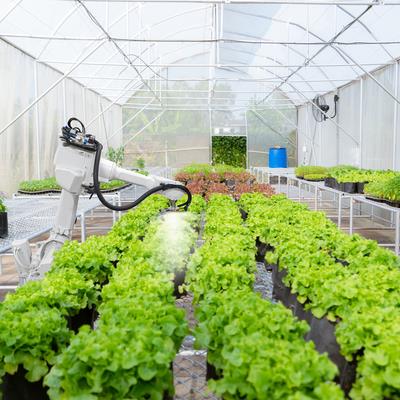CRISPR-Cas has transformed our ability to edit DNA sequences, with broad spectrum applications in agriculture, health, and beyond. The convergence of AI and CRISPR represents the paradigm shift in plant genome editing with potential benefits in food security, the environment, and healthcare. AI-driven models can precisely predict the efficient target sites, minimize the off-targets, predict editing outcomes, and improve the efficiency of genome editing in plants. Similarly, AI algorithms can analyze plant genomes to identify new genes associated with desirable traits, enabling researchers to precisely edit crop genomes for targeted improvement without any off targets. We may see transgene-free CRISPR-edited crops with improved nutritional content, pest and disease resistance, and better public acceptance. Together, these technologies hold an immense potential to revolutionize the field of gene editing in plants by addressing the challenges of climate change, sustainable farming, and food security. As the synergy between AI and CRISPR is evolving, we can expect intelligent gene editing to be an essential part of plant gene editing in the future. However, despite the immense potential of CRISPR and AI, it is very important to move cautiously, addressing challenges and ethical concerns to ensure these technologies’ responsible and safe use.
One of the critical challenges in plant genome editing is ensuring efficient gene editing with predictable outcomes and without any off-targets. AI tools are widely used to evaluate large genomic datasets of plants to identify the optimal target site for gene editing, predict precise editing outcomes with minimum off-targets, and design efficient gRNAs. Similarly, converging AI with high throughput screening techniques may enable researchers to screen thousands of genetic screens to identify the most effective genetic modification. For example, machine learning tools such as DEEP-CRISPR and CRISPR-ML have significantly enhanced the efficiency of the CRISPR-Cas systems. Similarly, AI tools can predict the precise outcomes of gene editing and the consequences of these genetic modifications on the plant phenotype. For example, an AI-based tool, PlantPredictor, can forecast the impact of genetic alterations on plant growth and yield. Regulatory and ethical issues remain challenging in public acceptance and commercialization of gene-edited plants. AI can help regulatory agencies ensure regulatory and ethical standards during their commercialization. AI can assist researchers in navigating the regulatory landscape of gene-edited crops, including the regulatory triggers for these crops. By addressing these challenges by integrating AI with CRISPR, scientists can unlock the full potential of gene editing in plants. This Research Topic aims to explore collaboration and share insights about intelligent gene editing in plants to drive plant genetic improvement.
As AI continues to evolve, it will play a significant role in reshaping the future of plant genome editing. This Research Topic focuses on the synergy between AI and CRISPR and its transformative potential in intelligent gene editing in plants. We invite submissions from a variety (original research articles, reviews, perspectives, methods, data reports, and commentaries) of manuscript types addressing the following themes:
1. Enhanced CRISPR Design:
•Role of AI algorithms in designing CRISPR experiments.
•Predictive models for optimization of gRNA
•Case studies demonstrating improved precision and efficiency in gene editing.
2. Advanced Delivery Methods:
•Recent trends in delivery systems for CRISPR cargoes in plants.
•Comparative studies of nanoparticle-based delivery, agrobacterium-mediated delivery, viral vectors, and other methods.
•Challenges and opportunities in achieving efficient and consistent delivery of CRISPR cargoes
3. Predictive Modeling and Simulation:
•AI-driven tools for predicting the outcomes of gene edits.
•Machine learning tools for evaluating the impact of genetic modifications on plant phenotypes.
•Integration of AI with high-throughput screening systems.
4. Predicting Off-Target Effects:
•AI tools for predicting the off-targets and reducing the risk of unintended genetic alterations
•AI-driven tools to improve the reliability and consistency of multiplex gene editing.
•Case studies for predicating off targets using AI tools
5. Applications in Agriculture:
•Case studies on developing gene-edited crops with improved traits using AI and CRISPR.
•Transformative role of AI and CRISPR for addressing climate change, food security, and sustainable farming.
•Ethical and regulatory considerations in the application of intelligent gene editing.
•AI in genetic editing workflow: minimizing safety concerns and maximizing the precise genetic improvement of plants
•AI and regulatory frameworks of gene edited crops
6. Unlocking Complex Genetic Interactions:
•Integrating AI with CRISPR to resolve the complex genetic interactions and regulatory networks underlying biological processes
•Machine learning to analyse multi-omics data (genomics, proteomics, transcriptomics and metabolomics to decipher the genetic components of complex traits in plants
•AI and CRISPR: functional characterization of genetic variations, dissecting disease mechanisms and identify novel genes for genetic improvement of plants
7. Future Directions and Innovations:
•Convergence of AI and CRISPR: emerging trends and prospects
•New and Interdisciplinary approaches in gene editing of plants.
•Rise of intelligent gene editing: potential impact on society and environment
•AI and CRISPR: challenges and opportunities



